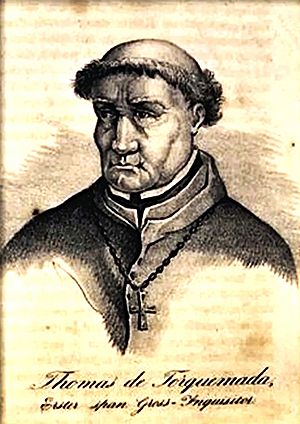Tomás de Torquemada facts for kids
Quick facts for kids
Tomás de Torquemada
|
|
|---|---|

Tomás de Torquemada. Unknown artist, 19th century.
|
|
| Grand Inquisitor | |
| In office 1483 – 16 September 1498 |
|
| Preceded by | Position established |
| Succeeded by | Diego de Deza |
| Personal details | |
| Born | 14 October 1420 Torquemada or Valladolid, Kingdom of Castile |
| Died | 16 September 1498 (aged 77) Ávila, Kingdom of Castile |
| Parent |
|
| Relatives | Juan de Torquemada (uncle) |
| Alma mater | University of Salamanca |
| Occupation | Friar |
Tomás de Torquemada (14 October 1420 – 16 September 1498) was a Spanish Dominican friar. He became the first Grand Inquisitor of the Spanish Inquisition. This group was created in 1478. Its job was to make sure people followed Catholic religious rules in the new Kingdom of Spain.
At that time, many Muslims and Jews in Spain faced difficulties. They found it helpful to become Catholic. Some people who converted from Judaism were called Conversos. They were sometimes thought to secretly keep their old beliefs. This was a concern for the Catholic Monarchs, King Ferdinand and Queen Isabella. Torquemada, who may have had converso ancestors himself, strongly supported the Alhambra Decree. This rule forced all Jews to leave Spain in 1492.
Torquemada's name is often linked with strictness and strong religious beliefs. This is because of the punishments given during the Inquisition. These punishments included burning at the stake for those found guilty. While torture was allowed, records show it was not used very often. During Torquemada's time, about 2,000 people were executed by burning.
Contents
About Tomás de Torquemada
Early Life and Education
Tomás de Torquemada was born on October 14, 1420. He was born in either Valladolid or the nearby village of Torquemada, Palencia. He joined the Dominican monastery of San Pablo when he was very young. He was known for being very religious and strict. He also had a good reputation for learning.
Later, he became the leader, or Prior, of the Santa Cruz monastery in Segovia. Around this time, he met Princess Isabella I. They quickly became close friends and shared similar religious ideas. Torquemada became her regular confessor and personal advisor. He was there when Isabella became queen in 1474. He even advised her to marry King Ferdinand of Aragon in 1469. This marriage helped unite their kingdoms. Torquemada also became King Ferdinand's confessor.
Starting the Spanish Inquisition
Torquemada was worried about people who had converted from Judaism or Islam. He believed they might threaten Spain's religious and economic life. The King and Queen asked Pope Sixtus IV to create a special office for an inquisition in Spain. The Pope agreed and set up the Holy Office for the Propagation of the Faith in 1478.
This meant the King and Queen could choose people to be inquisitors. The Pope would then officially appoint them. The Spanish Inquisition was largely controlled by King Ferdinand.
Torquemada as Grand Inquisitor
In 1482, the Pope appointed several inquisitors for Spain. Torquemada was one of them. A year later, he was named the Grand Inquisitor of Spain. He held this important position until he died in 1498. In 1484, he stopped being the royal confessor. Diego Deza, another Dominican, took his place and later became the next Grand Inquisitor.
In 1485, Torquemada created a set of twenty-eight rules. These rules guided how the inquisitors should conduct their investigations. Under his leadership, the Spanish Inquisition grew a lot. It started with one office in Seville and expanded to two dozen offices. He set up tribunals, or courts, in cities like Sevilla, Jaén, Córdoba, Ciudad Real, and Saragossa. His main goal was to remove all beliefs that went against Catholic teachings in Spain.
The Treaty of Granada (1491) had promised to protect the religious rights of Muslims. However, this changed with the Alhambra Decree on March 31, 1492. This new rule forced about 40,000 Jews to leave Spain. They could only take their personal belongings. About 50,000 other Jews chose to be baptized as Christians to stay in Spain. Many of these people, sometimes called "Marranos," secretly kept some of their Jewish traditions. They became a main target of the Inquisition.
Many people sent requests to Rome asking for mercy. The Pope became aware of Torquemada's strictness. He called the Inquisition's representatives to Rome three times. Even Queen Isabella and King Ferdinand were concerned about how much money was going to the Inquisition. They also complained to the Pope. But Torquemada remained in his powerful position.
Historians have different ideas about how many people were affected by the Inquisition under Torquemada. Queen Isabella's secretary, Hernando del Pulgar, wrote that 2,000 executions happened during her entire reign. This period went beyond Torquemada's death.
Later Years and Death
In his last years, Torquemada's health declined. In June 1494, Pope Alexander VI appointed four assistant inquisitors. They were meant to help Torquemada manage the Inquisition. Some historians believe these assistants were appointed because of complaints about Torquemada's strictness.
Torquemada still believed strongly in his mission. He retired to the monastery of St. Thomas Aquinas in Ávila in 1494. He lived a simple life as a monk there. In 1498, he held his last general meeting. New rules were made to help the Inquisition continue in Spain. These rules tried to fix some of the problems that people had complained about.
After fifteen years as Grand Inquisitor, Torquemada died at the monastery on September 16, 1498. He was buried there. His tomb was robbed in 1832. His bones were reportedly taken and burned in a way similar to an auto-da-fé.
See also
 In Spanish: Tomás de Torquemada para niños
In Spanish: Tomás de Torquemada para niños

